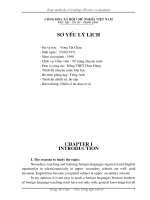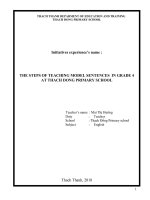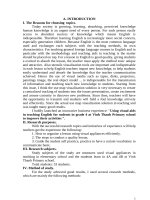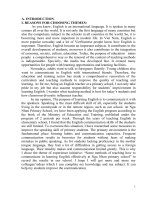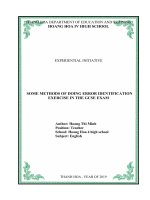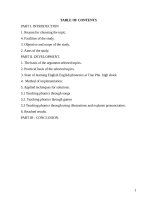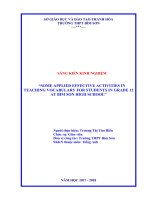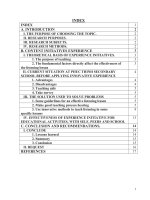Some methods of teaching how to communicate in learning english at nga nhan primary school
Bạn đang xem bản rút gọn của tài liệu. Xem và tải ngay bản đầy đủ của tài liệu tại đây (550.52 KB, 22 trang )
A. INTRODUCTION.
I. REASONS FOR CHOOSING THEMES:
As you know, English is an international language. It is spoken in many
corners all over the world. It is not only the first language of many countries but
also the compulsary subject in the schools in all countries in the world. So, it is
becoming more and more important in modern life. In Viet Nam, English is
more popular nowaday and a lot of VietNamese people know how English is
important. Therefore, English became an important subjects. It contributes to the
overall development of students, moreover it also contributes to the integration
of economy, society, culture, education. Today, the purpose of education trains
people a comprehensive way so the renewal of the content of teaching methods
is indispensable. Specially, the media has developed fast. It created many
opportunities for people with learning opportunities and learning facilities.
Nowadays, adults want to talk to foreigners fluently. Young children also
want to communicate in English with international friends. Therefore, the
education and training sector has made a comprehensive renovation of the
curriculum and teaching methods to improve the quality of teaching and
learning. As for me, being an English teacher at a primary school, I not only take
pride in my job but also assume responsibility for students’ improvement in
learning English. I wonder what teaching method is best for today’s students and
how classroom diversity influences teacher.
In my opinion, The purpose of learning English is to communicate it with
the speakers. Speaking is the most difficult skill of all, especially for students
living in the countryside or in the remote region, such as our school. At Nga
Nhan Primary School, we have been applying the English program according to
the book of the Ministry of Education and Training, published under the
program of 2 periods per week. Through the years of teaching English in
elementary school, I found that the English communication skills of the students
are still limited. To overcome this situation, I have researched some measures to
improve the speaking skill of primary students. The primary environment is the
fundamental place forming habits and communication capacities. Frequent
communication results in braveries for students without fears of making
mistakes in public speaking. As for students lacking proficiency in the mother
tongue language, they had a lot of difficulties in getting access to a foreign
language. Their timidity makes oral communication limited greatly. This is why
I chose the theme of experience initiative: “Some methods of teaching how to
communicate in learning English effectively at Nga Nhan primary school” to
record the results in our school. I hope I will get more and more my
colleague’sideas which I can complete my knowledge and my subject. It can
help my students improve the communication.
1
II. RESEARCH PURPOSES:
I am an English Teacher in a primary school, I constantly research,
actively, actively innovate teaching methods to improve the quality of teaching
and learning. I wrote this topic to share my small experience with my colleagues
to help students improve the knowledge and quality of English in
communication.
- Find out the current status of teaching speaking skills.
- Building the basis of teaching English and the methods help students
communicate.
- Evaluate empirical results and draw up useful pedagogical lessons.
III.RESEARCH OBJECTIVES AND SCOPE OF RESEARCH:
.........
As a result of the fact teaching and learning English at Nga Nhan
primary school, I only study my topic at Nga Nhan primary school.
IV. RESEARCH METHODS:
In order to implement my measures effectively, I have combined the
following measures:
- Research method: To get information effectively about teaching
methods, I used books and materials... especially through regular training
courses of the Ministry of Education and Training, Department Provincial
Education and Training organizations.
- Observation method: direct teaching hours in classes are assigned,
combined with other classes not directly taught through the class time and class
visits.
- Conversation method: Direct communication with students in class,
outside class to find information.
- Product research methodology: Through the test and the results at the
end of the semester and the double work process - student groups in classroom
activities.
B. CONTENT
I. IN THEORY:
English is an international language. It is very important in modern life now.
However, English is not compulsory in primary schools but it helps students
communicate and get the knowledge about economy, society, culture, in the
world, especially in the field of education. It requires English teachers to equip
the modern teaching methods. Learning English will not only help students
master the theory but also help students practice communicing.
For years, the teaching method for children has been similar to one for
adults apart from supplementing some songs and games into lectures. It’s clear
that the receptive process of our mother tongue language and the next process in
the school period are natural. Language capacity is generated by imitating,
unconscious learning through different forms such as communicating with
relatives, reading stories, connecting with communicating, singing, reading
poems, painting, etc. The difference of children’s receptive process in
2
comparison with adults is that adults’ receptiveness is conscious and annalistic
but children’s one is natural via intuition.
There are two kinds of material languages which almost every learner needs
develop: Receptive language and productive language. Receptive language is the
language factor possibly realized and not produced by learners. Productive
language is the language factor possibly used in speaking or writing. Students
will become familiar with realizing new factors through situations if those are
repeated many times. To practice using the receptive language, students have to
learn how to reflex with new words naturally. In curriculums, grammars are
sentences or questions and answers practiced more than once. It is essential that
samples are given clearly and fully for students to understand what they have to
do in some class activities.
II. IN REALITY:
As you know, learning and teaching English in Viet Nam are very
difficult especially learning and teaching English in primary schools. According
to the regulation of Ministry of Education and Training, there are only two
lessons per week that do not have enough time for students to develop
communication skills well. Several qualified schools could have more lessons,
four lessons per week. Hence, the period for students to get access to English is
obviously short in comparison with the total communicating hours every week.
Moreover, English environment is restricted in classroom hours and students
use Vietnamese when lessons end. Children don’t actually need to use English
except for the requirement of studying and examination. All the requirements
using English are practical and there isn’t other natural English environment for
children. Moreover, English is a optional subject in primary schools. English
subject isn’t also used to select the result of the students in primary schools so
some students do not pay much attention to English. Their vocabulary is not
rich. They are difficult to communicate.
Children are so unable to concentrate on what teachers are delivering in a
long period. Consequently, they should be engaged in different activities, to
perform various tasks by themselves with exercise types always changed and
diversified communication situations.
Children often obtain and imitate knowledge quickly and also forget what
have learned quickly. They are naturally curious, dynamic and creative. Children
always demand to discover outside environment and interact with others. It
cannot be denied that they are interested and creative in games.
Because of the above reasons that led to the quality of education is not
high. Through the survey on the quality of pupils at grade 3, 4 and 5 at Nga
Nhan Primary School in the beginning of school year 2015-2016 achieved as
follows:
3
Total No. of
Excellent
Quite good
Medium
Bad
students
No.
%
No.
%
No.
%
No.
%
39 (grade 3)
8
21
9
23
18
46
4
10
50 (grade 4)
12
24
15
30
20
40
3
6
57 (grade 5)
13
23
16
28
25
44
3
5
With the result above, from early school year, I always try to find the best
methods to design interesting lectures inspiring students so that they could turn
what they have learned into productive language via oral communication,
integrate with the developing tendency of foreign language subject: learning a
foreign language is learn how to communicate but not focusing on grammar as
in the past.
III. SOLUTIONS TO THE PROBLEM:
Solution 1: Improving the students’ awareness about learning how to
communicate in English.
Propaganda is the first method chosen to raise awareness for students.
As you know, some primary students don’t pay more attention to learn
and communicate English because it is only a optional subject in primary
schools. It is also a difficult subject at school. Therefore I always persuade my
students about the importance of communicating English. If the students speak
English well, they can communicate English with the speakers, they can travel
over the world, they can be easy to make friends with the foreigners, they can
chat with the foreigners on facebook or zalo, they can be easy to find a good job
with the high salary in the foreign company in the future, they can read books,
newspapers, stories or watch films in English. Thank to my persuasion, my
students can understand why they should communicate in English. When they
understand the important role of speaking, they will be hard-working to take part
in communicating English effectively.
Solution 2: Teachers should communicate in English much more than
Vietnamese in the classroom language:
To help students speak English well, Teacher should encourage students to
use English as much as possible. Classes should provide opportunities for
students to communicate in a variety of forms: T- Whole class, TS, S-S. The
teacher is the person who guides the children to make simple situations and
subject-based conversations.
Beginning of lesson:
*Good morning. How are you?
*Did you have a nice weekend?
*Have you done your homework?
*Let’s play a game now, shall we?
*Are you ready?
Ask for repetition:
*Would you mind repeating…?
*Could you say it again?
4
*Pardon?
Asking for clarification:
*What is it? Please tell me again.
*What do you mean?
*Could you explain more about..?
Ask for ideas/opinions
*What do you think about that…(name)?
*Do you have any ideas/opinions?
*How about you?
Checking:
*Is that clear?
*Okay so far?
*Have you got it / that?
During English lessons, Teacher should speak English much more than
Vietnamese and use a mixture of the two languages.
English
Vietnamese Both
ü
Introducing the lesson
ü
Checking attendance
ü
Organizing
ü
Classroom control / discipline
ü
Giving praise
ü
Presenting new language
ü
Introducing a new text
ü
Asking questions on the text
ü
Correcting errors
ü
Setting homework
Solution 3: Improving communication through using pictures.
Nowadays, modern teaching methodology encourages the use of as many
media, especially pictures as possible in classroom. At the same time, the
innovation in English teaching at general education level demands that the
schools should provide students with a good communicative skill in English.
However, nowadays teaching English speaking at many Lower primary school
as well as the using of pictures in English speaking classrooms to motivate
learners haven’t been paid due attention to. Therefore, this article aims at
researching the use of pictures in English speaking classes at lower primary
schools and put forward some practical suggestions to improve the quality of
English speaking teaching and learning. I usually use the pictures to help my
students practice communicating in all of the lessons. My students are very
practical when I use the pictures, my students can be easy to talk and
understand.
English 3 –Unit 17 –Lesson 2( Point and say and Let’s talk )
To practise the structure: How many ….. do you have ? - I have ……..
5
I ask my students to look the picture ask and answer about quantity.
Example: picture a
picture b
S1: How many dogs do you have ? S1: How many goldfish do you have ?
S2: I have two dogs.
S2: I have three goldfish.
English 4 –Unit 16 –Lesson 2( Point and say )
To practise the structure: Why do you want to go to the …?- Because…..
I ask my students to look the picture ask and give reasons for going
somewhere.
Example: picture a
S1: Why do you want to go to the zoo?
S2: Because I want to see the animals.
English 5 –Unit 16 –Lesson 1( Point and say )
To practise the structure: Excuse me, Where’s the….? – It’s …..I ask
students to look the picture to ask and give directions.
6
Example: picture a
S1: Excuse me, Where’s the bus stop?
S2: It’s next to the stadium.
English 5 –Unit 16 –Lesson 1( Let’s talk )
To revise the structure: Excuse me, Where’s the….? Ask students look the
picture, ask and answer questions about directions. Example you are in the bus.
S1:Where’s the park?
S2: Turn right. It’s opposite the stadium.
S1: Where’s the stadium?
S2: Turn right. It’s on the corner of the street. It’s opposite the park.
I always try to use the pictures to teach my students how to communicate
in the part “pre and post” for reading, listening and writing skills. This helps my
students speak English everywhere and everytime.
Example: English 3 –Unit 14 –Lesson 3( 5. Read and write)
- Pre-reading and writing: Ask students to look at this picture to answer
my questions.
7
Teacher: What room is it?
Ss: It is a dining room.
T: How many tables are there?
Ss: There is a table.
T: How many chairs are there?
Ss: There are six chairs.
…………………….
- Post- reading: “Chain game”: Students work in group of 5 to talk about
their dining room.
Examples: S1:This is a dining room. It is not very big but nice. There is a TV.
S2: This is a dining room. It is not very big but nice. There is a TV, a
cupboard under the TV.
S3: This is a dining room. It is not very big but nice. There is a TV, a
cupboard under the TV and many pictures on the wall.
Example: English 4 –Unit 17 –Lesson 1(3.Listen and tick)
- Pre-listening: Ask Ss to discuss in pairs to talk about the colour and
guess the price of these clothes.
Students talk: The jacket is yellow. It is 60,000 dong. The T- shirt is red. It
is 75,000 dong. The jumper is blue. It is 60,000 dong.
8
- Post -listening: Ask Ss to work in pairs to ask and answer the price of
these clothes.
S1: How much is the yellow jacket?
S2: It is 60,000 dong.
S1: How much is the red T- shirt ?
S2: It is 75,000 dong.
S1: How much is the blue jumper ?
S2: It is 60,000 dong.
To sum up, my students are primary students so they can’t think of
complexly. The pictures are easy for them to imagine. They will be confident to
communicate.
Solution 4: Improving communication through work in pairs and groups.
With this method, it is necessary for students to develop their ability to
learn in a positive, active and creative way. They have to show themselves, find
out, find out and conquer the self. And in my opinion, through group work in
some activities, when students have learned how to work in groups, they have
the conditions to cooperate, learn from each other and take responsibility.
Responsible for special group members who self-dominate knowledge if the
teacher organizes and guides well. Team teaching is an active method in which,
the number of students is divided into groups in certain ways. In each group,
students have chances to boost listening and speaking skill and learn from one
another. They will be more confident in communicating in a foreign language.
Example: English 4 –Unit 16 –Lesson 1(Point and say)
+ Teachers ask students to work in group in part “Point and say” to
suggest some places to go and say why. Then, a pair of representatives in each
group go to the board, point to the picture, suggest.
+ Each group understands what they have to do is applying a sentence
structure: “Let’s go to the ………….I want to ………..” to practice suggesting
some places to go and say why.
- Under the assignment of group leaders, each member in the groups have
to understand what he/she has to perform and actively participate in group
activities at the same time.
+ According to the request of the above practicing exercise, a class is
divided into some certain groups (6 students per group) and is organized as
following:
+ The group leader assigns as:
- Pair 1: suggest some places to go and say why in picture A: bakery/buy
some bread.
- Pair 2: suggest some places to go and say why in picture
B: pharmacy/buy some medicine.
- Pair 3: suggest some places to go and say why in picture
C: pharmacy/buy some medicine.
9
- Pair 4: suggest some places to go and say why in picture D: sweet
shop/buy some chocolate.
+ The group leader asks Pair 1 to practice and the rest of groups to listen.
Then, take turn to group 2, 3, 4. Therefore, every member could listen and
practice the whole lesson. If any member in one group is confused and unable to
practice fluently, he/she will be supported by the group leaders and other
members in the group. Teacher should divide the class into groups with students’
relatively equal learning capacity. In each team, communication skill of
members has to cover all of 4 levels: good, quite good, medium and weak.
Appointing students with very good English capacity to different groups for
controlling the practicing process. Teachers should care for, encourage students
with weak learning capacity and give complements, reward ones with good
performance.
Work in the group in class 3a at Nga Nhan primary school
Solution 5: Improving communication through activities.
Nowadays, many students have a lot of good vocabularies and grammar
but they can not speak English very well. Teacher should spend many times for
students communicating. So I used lots of activities to help them listen and
speak.
1.Mapped Dialogue.
Example: English 5 Unit 15 Lesson 2 (Let’s talk)
To revise how ask and answer questions about their future jobs. I use this
Mapped Dialogue.
You
your friend
What- like- be- future?
Why – a writer?
A writer
Because- write stories. Would- a writer
No- a pilot
Because- fly a plane
Why – a pilot?
10
I ask my students to look the mapped dialogue ask and answer questions
about their future jobs.
Example dialogue
You: What would you like to be in the future ?
Your friend: I’d like to be a writer.
You: Why would you like to be a writer?
Your friend: Because I’d like to write stories for children. Would you like
to be a writer?
You: No. I’d like to be a pilot.
Your friend: A pilot? Why?
You: Because I’d like to fly a plane.
2. Survey
* Survey: English 3 –Unit 14 –Lesson 2 ( Let’s talk)
To revise how ask and answer questions about the quantity. I use the
survey table.
fans
mirrors
doors
windows
2
3
5
4
I ask my students to ask and answer about the quantity.
Example exchanges
S1: How many fans are there?
S2: There are two.
*Survey: English 4 –Unit 11 –Lesson 2 (Let’s talk )
To revise how ask and answer questions about the time of the daily
activities/routines. I use the survey table.
Name
get up
have breakfast Have dinner
Go to bed
Mai
6.00
6.30
7.30
9.00
I ask my students to ask and answer about the time of the daily
activities/routines.
S1: What time do you get up ?
S2: I get up at 6.00.
3. Visuals.
English 3 –Unit 8 –Lesson 1( Point and say)
To introduce about the school things. I prepare some school things. I call
some students to go to the board pick up them and introduce.
* Students pick up a pencil, a pencil case, a school bag and introduce:
This is my pencil.
This is my pencil case.
This is my school bag.
……..
4. Noughts and Crosses : English 4 Unit 12 Lesson 2 (Let’s talk)
To practice two structures:- Where does a……work? - A……works…
- What does your …….do? - She’s/he’s……
11
I use “Noughts and Crosses”
1,Doctor/ in a hospital
2,Farmer/ in a field
3,Worker/ in a factory
4,Clerk/ in an office
5,Father/ farmer
6,Mother/ nurse
7, Friend/ pupil
8,Brother/factory worker 9,Sister/ student
1. Where does a doctor work? - A doctor works in a hospital.
2. Where does a farmer work? - A farmer works / in a field.
………………………………………………………………..
9. What does your sister do? - She’s a student.
5. Brainstorming
T gets Ss to think about their after shool activities.
T gets them to go to the board and write down the activities they think
play soccer
listen to music
read
after school
activities
Possible answers:
. Tidy room, read comics, watch TV, go to the circus.
. Go to the movies theatre, go to the zoo, go shopping
. Play video games, go to the cafeteria
Solution 6: Improving communication through games.
Besides teaching methods that promote the activeness and creativity of
today, I do it regularly and effectively. I often apply some learning games during
lessons to reduce cramming and to make the lesson more interesting, to help
students active.
Learning games are a special kind of game, not only help the students to
entertain, but also to help them acquire knowledge through the game or
reinforce what they have learned. A new teaching method could create an
amount of inspiration and creativities for teachers. Each teacher has his own
unique creativities during teaching process. If teachers repeat the same method
in every lesson, students will get bored and even feel that lessons come as
normally without inspiration and expectation. Games are also considered to be
an important entertainment form. In fact, they could be used to consolidate
material languages as shown above by the method attracting students. In all
every form, games could perform functions of exercises of practicing skills
because we can review and introduce material languages in funny and wellorganized ways through games. The method of skill practicing section often
goes with repeating with teacher-centered. The method takes effects when
students learn new words and sentence structures. On the contrary, games are
often open-ended and student-centered. There are various types of games.
Several ones focus on vocabularies or sentence structures. And there are games
promoting both vocabularies and sentence structure. Here are several games that
I usually apply into my lecture in my class:
12
+ Guessing Game
- Class is divided into two teams. Small learning tools (pencil, eraser, pen,
ruler, and book) are put in a bag or put on the table and cover them tightly). Call
a student from team A, ask him or her to thrust in the bag and take a thing (hand
still in the bag) and question “is this a (pencil)?” One student in team B touches
that thing, guesses without sight and answers Yes it is or No, it isn’t. It is a
(book). The team has correct answer will be added 1 point. The game will be
end when all students are taken their turn.
+ Whisper
Class is classified into 3 groups, each group sit vertically. Teacher give
students who sit in the beginning of ranks a word or sentence (S1). S1 whispers
that word for the next student (S2). The activity is carried on until the last person
of a rank takes his/her turn. When receiving the word or the sentence, student
stands up and speaks loudly then quickly runs to the board and writes in on.
Which team completes first will be the winner.
Play game “Whisper” in class 3a at Nga Nhan primary school
Through the way organized the games, I feel my students exciting,
confident while they play and their English-speaking ability has improved
significantly. This is said that we know how to change the content, form of
teaching English, the quality of the course will be achieved than I expected.
+ Lucky number.
Students select the 1-9 number you like. If you choose the lucky number,
you do not have to answer the question but get points (2 points for one). If not
the lucky box then the team must answer correctly to score points. If the team
chooses not to answer, the chances of scoring for the opposing team (If both
teams do not have the right answer, the chance will be for the audience). The
winner is the team with more points. (If two teams score points, the winner will
be the more lucky). The sequence numbers of the crossword correspond to the
question the teacher has prepared according to the content of the unit.
13
English 3 Unit 10 Lesson 2 (Let’s talk)
To revise two structures: “What do you do at break time?- I…..” and
“Do you like…….?- yes, I do/ No, I don’t”. I hold my students to play game:
“Lucky number” for them to ask and answer in the pairs.
1.Look at the picture to answer the question: What do you do at break
time?
2.
3.
4. Look at the picture ask and answer the question: Do you like…….?
5. Look at the picture to answer the question: What do you do at break
time?
14
6. Look at the picture to answer the question: What do you do at break
time?
7.
8. Look at the picture ask and answer the question: Do you like…….?
9. Look at the picture ask and answer the question: Do you like…….?
15
Example: 1. S1: What do you do at break time?
S2: I play hide and seek.
2. Lucky number……
When I applied the "Lucky number" game during this period, I found the
students to be very active, including the weak, shy students. After the game
students are very excited and they can remember how to ask and answer about
the fun activities during the play.
Solution 7: Improving communication through songs and chants
As you know, The students want to learn English well, the first thing we
have to do for children to love it. Music is the comunication that will help them
get closer to this subject. When they sing or read chants, They will fell more
comfortable. They are easy to remember the structures.
* Perform:
In addition to the songs and the chants on the program, I also collected
some internet games, tapes for children's ages to teach them. Primary students
are very active and enjoy singing, fun songs and the chants that make them
interested. Through this, students will study English more. Teachers need to
explain the meaning and content of the song so students understand, appreciate
the song. Since then, they are more interested in singing better. Students sing
groups and groups and can let them choose their own songs. When teaching new
songs, I integrated into the class assignments to both reduce stress and provide
more songs for students. In addition to help students remember structure
sentence quickly, I often repainted the structure according to the songs that they
have belonged like: "that is a yellow butterfly".
Exxample: To revise how ask and answer questions about the weather. I use this
song and this chant.
16
After the students learn this song and this chant by heart. My students are
easy to talk about the weather. Learn to sing, sing to learn.
Solution 8: Encouraging the students to make dictionary themselves.
The students want to communicate in English well, they must have good
vocabularies and structures. The primary students often limit about reference
books, newspapers, the internet, television so I encourage the students to make
dictionary themselves to consolidate and remember the learned words longer.
* Perform:
- On the second week of the beginning of the school year, I ask each
student to prepare a pocketbook to rewrite all the words which they learned. Ask
students to organize and write thematically (subject, matter, animals, colors,
weather, etc). I instruct students to do the following: devide notebooks into
multiple themes so they are more convenient to use. Next, divide the page into
two sections. The one side writes English, and the other writes meaning of
Vietnamese.
Example:
TOPIC ABOUT THE SCHOOL THINGS
English
Vietnamese
* a ruler
à
1 cây thước
* a pen
à
1 cây bút mực
* a desk
à
1 cái bàn học
* an eraser
à
1 cục tẩy
17
To make the dictionaries more atractively, I ask my students to draw or collect
images illustrating Vietnamese meaning.
Example:
TOPIC ABOUT THE NATURE
English
Vietnamese
* a tree
à
* trees
à
* a cloud
à
* clouds
à
18
* a flower
à
* flowers
à
Solution 9: A smiling face and never stop students talking.
Teachers should encourage the students to practice English. A smiling
face and keep saying “Well done” makes them feel more self-confident to speak.
If the teachers say “No, you are wrong”, students will be afraid of making a
dialogue. The teachers are always interrupting students while they are speaking
English. That’s a very big mistake. The teachers have to let them speak freely
and fluently. Even though they made a mistake or more, the teachers should
keep silent until they finish the whole sentence or the whole dialogue. After that,
the teachers order the other students to correct the pronunciation and the
grammar. We give remarks and correct finally. Teachers impress students; help
students raise the creativity in communication and make the relation between
teacher-student and student-student in class more close and encourage
increasingly joyful atmosphere in class.
IV. EFFICIENCY OF EXCELLENT EXPERIENCE:
After a practical semester, “Some methods of teaching how to
communicate in learning English at a primary school”.
We recorded the results of the final test of the school year: 2015- 2016 as
follows:
Total No. of
students
39 (grade 3)
50 (grade 4)
Excellent
No.
%
11
28
16
32
Quite good
No.
%
11
28
18
36
Medium
No.
%
17
44
16
32
Bad
No.
%
0
0
0
0
19
57 (grade 5)
17
30
20
35
20
35
0
0
*The above results show that the percentage of students scoring good,
relatively high and without weaknesses. However, if not for the review questions
and more topics, the results will be lower. However, this is the encouraging
result of my students and my school.
* Speaking skills are also assessed throughout the student's learning
period in a semester. We score points to encourage good ideas, actively discuss
and actively respond to Teacher's open question. Although my students and I
tried very hard, the quality was not as expected.
C. CONCLUSION & SUGGESTIONS:
1. CONCLUSION
The project not only helps me get familiar with science investigation but
also penetrate, discover and present the methods conducted in the experience
initiative. Thus, the quality of teaching and learning is more and more enhanced;
students’ foreign language learning capacity is increasingly improved. Students
are more and more interested in the subject, they are looking forward to the
upcoming English lessons. Students who are shy, lazy, mispronunciation are
significantly reduced. The above proposals, which must have included
shortcomings are solutions drawn by the real investigation and examination. I
am very welcome to receive suggestions and supporting ideas from higher
entities, school Board and colleagues in order that my solutions are more
efficient.
In conclusion, I do hope that students love studying English more and more.
If they want to speak English fluently and communicate well, they also have to
improve their knowleage of other fields such as science, history, liturature and
social knowleage. They should explore the differences between Western and
Eastern culture and customs.
2. SUGGESTIONS
In order to enhance English communication capacity in school, I would
like to make proposals as follow:
- It is necessary for higher entities, bodies to help teachers stand the
chance of being trained in terms of teaching primary school course of English.
Therefore, teachers can be further provided with knowledge and learn from
colleagues in order for improving profession skill.
- It is needed for entities, school board and parents to develop learning
facilities such as computers, projectors, photocopy machines, scanners, cameras
so as to help student enhance English communication capacity.
- Evaluation and merit is needed strengthening, and teaching creativity is
necessary to be encouraged in each lesson.
I am looking forwards to receiving a respond to my experience initiative
from an expert opinion.
Thank you very much indeed.
20
Xác nhận của thủ trưởng đơn vị
Nga Nhan , April 13th 2017
I guarante that the experience
innitiative is written by myself without
coppying.
The writer
Mai Thị Cúc
LISTS OF EXPERIENCE INITIATIVE HAVE BEEN ACHIEVED
FROM THE SCIENCE COUNCIL OF EDUCATIONAL AND
TRAINING SERVICE, DEPARTMENT EDUCATION AND
TRAINING
Full name: Mai Thị Cúc
Occupation: Teacher
Work unit: Nga Nhan primary school.
Number
Lists of experience
initiative
The
classification
School year
Result
21
1
2
3
4
5
6
Kinh nghiệm dạy từ mới
trong phần thực hành
Tiếng Anh tiểu học.
Một số kinh nghiệm dạy
từ vựng ở Tiếng Anh
Tiểu học.
Một số kinh nghiệm dạy
tiếng Anh tiểu học
thông qua các trò chơi.
Kinh nghiệm bồi dưỡng
học sinh giỏi môn Tiếng
Anh khối 5.
Kinh nghiệm bồi dưỡng
học sinh giỏi môn Tiếng
Anh khối 5 tham gia
cuộc thi IOE trên mạng
Internet đạt hiệu quả
cao.
Một số biện pháp dạy
giao tiếp Tiếng Anh có
hiệu quả ở trường Tiểu
học Nga Nhân.
science council
Province
C
2008-2009
Province
B
2011-2012
Province
B
2012-2013
Province
C
2013-2014
Province
B
2014-2015
Province
A
2016-2017
22

